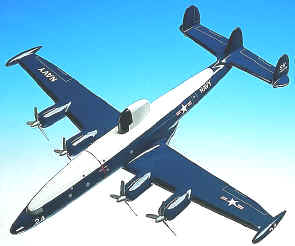|
|
|

|
Lockheed
WV (EC-121) Warning Star |
 |
|
The Lockheed EC-121 "Warning Star"
is a variant of the C-121 transport aircraft, which, in turn,
was the Air Force version of the famous L-1049 Super
Constellation airliner. They were called "Connies" by the pilots who flew
them,. Their primary mission was airborne early
warning. A radome height-finding radar
antenna (called the "camel back") was mounted on the
top of the fuselage and a large radome was placed under it.
The navy purchased 142 "Connies."
Several were the C-121 transport version; they were used to
fulfill its obligation to the Military Air Transport Service.
The bulk of them were the Electronic or EC versions. They
were used to maintain early warning barriers over the Atlantic and Pacific
Oceans. In 1965, BMEWS, the Ballastic Missile Early
Warning System, assumed the responsibility over the northern
approaches to the North Atlantic. Connies also performed weather, electronic- and photo-reconnaissance.
During the Vietnam war, both the Air
Force and the Navy used the EC-121 in a variety of roles ranging from
airborne aircraft command and control and early warning to electronic
surveillance. a replacement for them in these roles was never found.
A Navy C-121J nicknamed
the "Blue Eagle" served as an airborne radio and
television transmitter for the armed forces network in South
Vietnam. Another "Warning Star" made news on
April 14, 1969 when it was shot down over the Sea of
Japan by North Korean aircraft with the loss of the entire
thirty-one man crew. This attack prompted the United States to
deploy Task Force 71 to Asian waters.
|
|
 |
EC-121 Warning
Star, USN
Premier Series. 1/92nd scale. 15.65" wingspan x
14.35" long.
No. AFP3D-PR. Only $174.95 |
 |
WV-2
(EC-121) Warning Star, USN
Standard Series. 1/72nd scale.
20.25" wingspan x 19.25" long.
No. AFP3D-ST. Only $159.95 |
|
|
See:
Lockheed
1049 Super Constellation | USAF
EC-121 |
|
